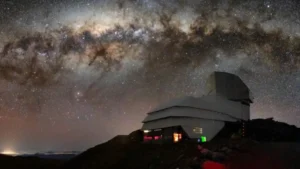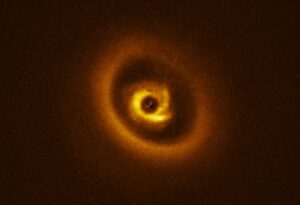Space weather report: hot with a chance of solar winds and coronal mass ejections.
The weather conditions in our solar system are more important than you’d think. What happens up there has a huge impact on everything down here, from communications to electrical power grids. We take a look at some of the most powerful solar superstorms to hit Earth.
What are solar storms?
Geomagnetic storms are disturbances in the Earth’s magnetosphere because of the interaction between Earth’s magnetic field and incoming solar winds. Such storms are often characterized by brilliant, kaleidoscopic auroras in the night sky in high-altitude areas.
These storms are not exclusive to Earth and can be found on other planets like Jupiter, Saturn, Venus, and Mars. The solar wind can come from coronal mass ejections (CMEs), solar flares, or coronal holes, and these all arise from sunspots.

Sunspots. Photo: Shutterstock
These dark spots on the surface of the Sun are quite commonplace, they are cooler areas on the Sun’s surface. Rather than experiencing convection, the spots have high concentrations of magnetic activity and flux. They move around the Sun, disappear and reappear, and can measure up to 160,000km in size.
Sometimes, you can even see sunspots from Earth without a telescope. Because of high magnetic activity, they often eject incredible amounts of plasma, solar particles, and magnetic fields into space.
Carrington event of 1859
In September 1859, English amateur astronomer Richard Carrington and his colleague Richard Hodgson were observing sunspots through a telescope. After studying and documenting the spot, they suddenly noticed what Carinngton described as a “white light flare.” It was a massive CME, lasting five minutes. A few days later, the world began to feel the effects.
At the time, telegram was the main medium of communication and the solar storm stopped messages from going through. Circuits and machines sparked up and some caught fire.
The storm created an intense aurora. Witnesses described their confusion as the night sky was illuminated and birds awoke in the middle of the night. Many believed the world was ending as the aurora painted the skies red.
To this day, it is the largest solar superstorm on record.
Geomagnetic storm of November 1882
Unlike the Carrington event, which did not cause too much damage, the 1882 geomagnetic storm showed the world that a lot more was at stake the more technologically developed it became.
Telephones and electricity had slowly started to make their way into people’s homes and the world was more interconnected than ever before. When the geomagnetic storm hit between November 11 and November 26, the telegraph system failed again, telephones either could not make calls or rang continuously, and switchboards caught fire.

The mysterious aurora beam. Photo: Capron, 1883
An aurora appeared and was visible as far south as Florida and there was an odd beam of white light above the moon. Onlookers stated that it looked like a torpedo and was detached from the aurora. Astronomer Edward Maunder called it coronae borealis.
New York railway storm
Astronomers dubbed the geomagnetic storm of 1921 as the most powerful of the 20th century. A lone but menacing sunspot called AR1842, thousands of kilometers in size, erupted during a period of low sunspot activity. It hurled several CMEs our way and sparked a series of crazy communications blackouts and devastating fires.
The storm heavily impacted telegraph systems, telephones, and train lines, particularly in New York City. On May 16, the New York Times called it “the worst electrical disturbance in memory.”
The phenomenon occurred for three consecutive days. In New York, the storm fried the telegraph system, and the signal and switch system at the New York railroad tower caught fire and forced all operations to stop, causing thousands of dollars in damage. Disturbances and fires were also reported at telegraph systems throughout the United States, France, and Sweden. Even ocean floor cables were not exempt from the solar wrath.
The aurora created by the storm was visible from the equator.
March 1989 geomagnetic storm
In mid-March 1989, the world was still locked in a Cold War. Ordinary citizens deeply felt the geopolitical tensions, fearful of nuclear war. So, when a bright aurora showed up in the skies of the southern United States, panic ensued. Many thought the Soviets had launched a nuclear attack.
In reality, a CME, in conjunction with a powerful solar flare, sent a powerful geomagnetic storm to Earth.
According to NASA, within the first few minutes of the storm’s arrival, over 200 electrical power grid issues arose in the United States. Parts of Canada were perhaps harder hit. The storm knocked out the Hydro-Quebec power grid, casting the northeast in nine hours of darkness and affecting over six million citizens.
Airports throughout Canada ceased operations and metros in cities like Montreal shut down. In Earth’s orbit, satellites failed and the Space Shuttle Discovery experienced difficulties with equipment.
2003 Halloween storms
The Halloween superstorm of 2003 took place during a period of supposedly low solar activity. Yet a group of sunspots over 13 times the size of our planet produced around 17 solar flares. The storms bombarded Earth from October 19 to November 7.
Voyager probes 1 and 2 recorded the event.

Aurora in Texas during the Halloween storms of 2003. Photo: Christie Ponder/NASA
The solar storm mainly affected aircraft and satellites. Aircrafts had to re-route themselves or stay at a certain altitude, GPS systems failed, and satellites, televisions, and radios malfunctioned.
Some areas experienced communication blackouts for over 100 hours. Onlookers observed auroras in Texas, Florida, Australia, and the Mediterranean.
Recent solar activity
While we haven’t had as large a solar storm recently, some bouts of solar wind do cause inconveniences. In February 2022, a mild storm caused some Starlink satellites to malfunction, fall, and burn up in Earth’s atmosphere.
A storm on the scale of the Carrington Event is rare. Researchers estimate if an event of that magnitude happened today, it would cause over two trillion dollars in damage.





